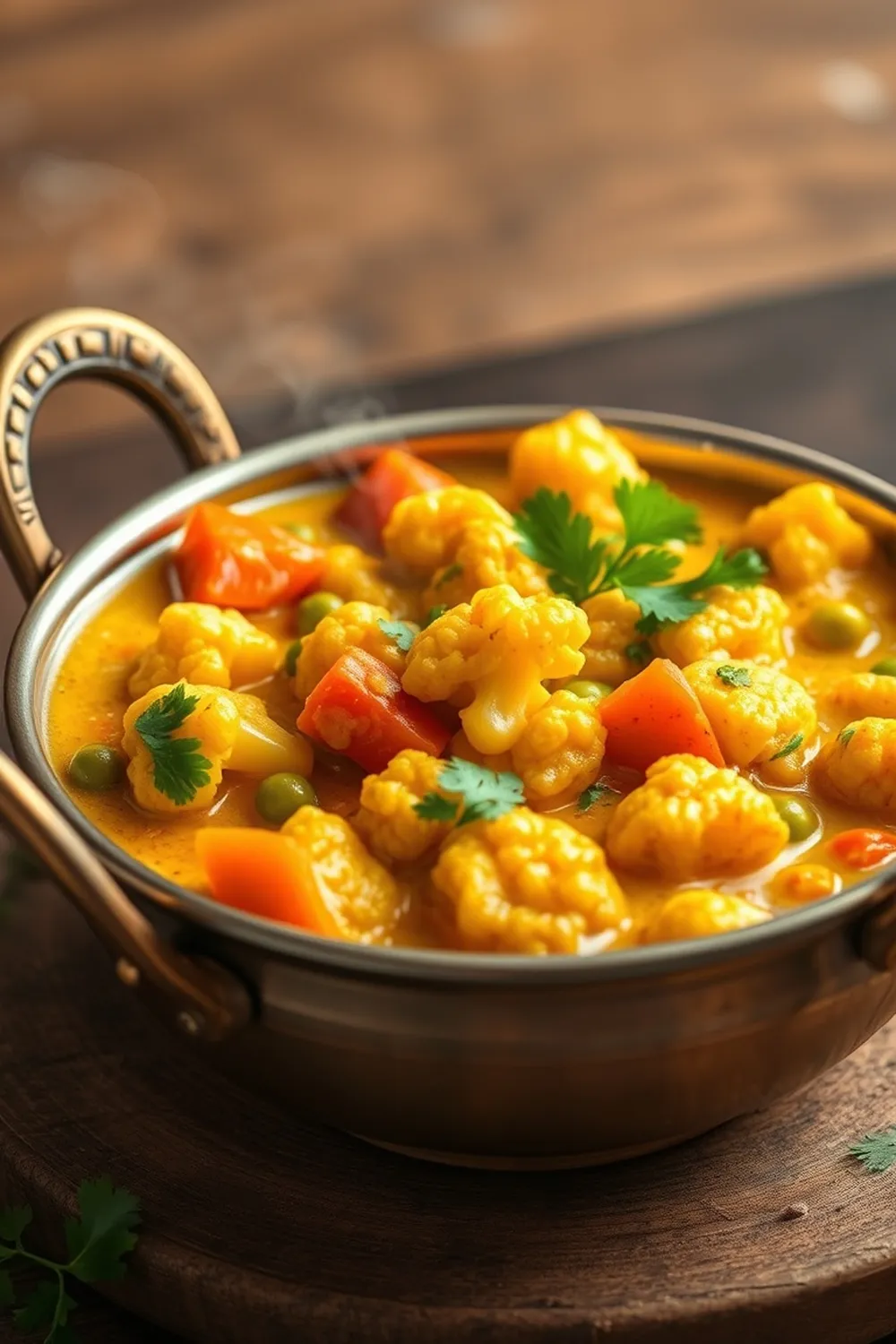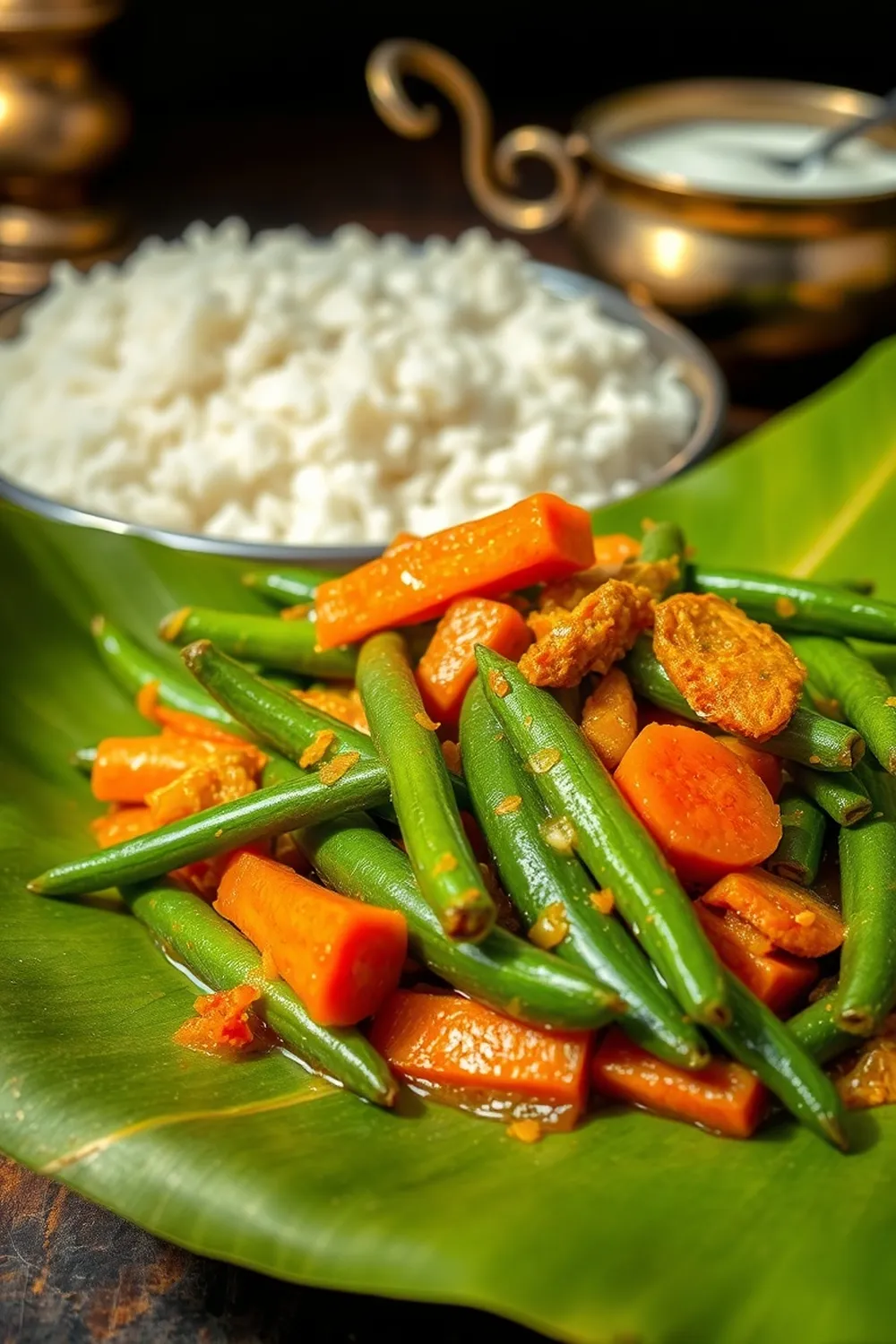- Soak cashews, melon seeds, and poppy seeds in water for 30 minutes to 1 hour; blend into a smooth paste.
- Chop vegetables (onions, cauliflower, carrots, beans, potatoes, peas, tomatoes). Parboil vegetables (except onions and tomatoes) with salt until slightly tender.
- Heat 1 tbsp oil, fry parboiled vegetables for 3-4 minutes. Set aside.
- Heat 2 tbsp oil, add cumin seeds, cloves, cardamom pods, and cinnamon stick. Sauté until aromatic.
- Add onions and green chilies; fry until translucent. Mix in ginger-garlic paste and cook until the oil separates.
- Add coriander powder, cumin powder, turmeric powder, and red chili powder. Stir well.
- Add tomatoes; cook until the oil separates. Mix in fried vegetables and tomato paste. Cover and cook for 2 minutes.
- Stir in brown onion paste and yogurt (curd). Add cashew paste; cook covered for 3-5 minutes.
- Pour 1.5 cups water; simmer for 15-20 minutes. Sprinkle garam masala and garnish with coriander leaves.
- Calories:280 kcal25%
- Energy:1171 kJ22%
- Protein:6 g28%
- Carbohydrates:35 mg40%
- Sugar:10 mg8%
- Salt:320 g25%
- Fat:14 g20%
Last Updated on 6 months ago by Neha Deshmukh
Authentic Vegetable Korma Recipe – Cashew & Poppy Seed Curry
Introduction
There’s just something so comforting about a good Korma. It’s creamy, fragrant, and packed with flavour – a true celebration of Indian cuisine! I remember the first time I attempted this recipe; I was a little intimidated by the paste-making, but honestly, it’s so worth the effort. This Vegetable Korma is a family favourite, and I’m thrilled to finally share my version with you. It’s perfect for a weeknight dinner or a special occasion.
Why You’ll Love This Recipe
This isn’t just any Vegetable Korma. We’re building layers of flavour with a rich cashew and poppy seed paste, creating a truly luxurious texture. It’s a wonderfully balanced dish – not too spicy, but definitely not bland! Plus, it’s a fantastic way to get your veggies in. You’ll love how easily the flavours meld together, resulting in a curry that’s both satisfying and sophisticated.
Ingredients
Here’s what you’ll need to create this delicious Vegetable Korma:
- 2 cups onions
- 1 cup cauliflower, cut into florets
- 1 cup carrots, chopped
- ¾ cup french beans, trimmed and chopped
- 1 cup potatoes, peeled and cubed
- ½ cup green peas
- 1 cup tomatoes, chopped
- 1 tbsp ginger-garlic paste
- 5-6 green chillies, slit (adjust to your spice preference!)
- 1 tsp cumin seeds
- 3 cloves
- 4 green cardamoms
- 2 inch cinnamon stick
- 1 tsp coriander powder
- ½ tsp cumin powder
- ¼ tsp garam masala powder
- 2 tbsp brown onion paste (from about 2 onions)
- 2 tbsp curd (yogurt), whisked
- 3 tbsp tomato paste
- 3 tbsp oil
- 2 tbsp cashews
- 1 tbsp melon seeds
- 1 tsp poppy seeds
Ingredient Notes
Let’s talk ingredients! The key to a fantastic Korma really lies in the quality and preparation of a few key components.
- Cashews: These aren’t just for thickening; they add a subtle sweetness and richness. Make sure they’re good quality!
- Melon Seeds (Magaz): These little seeds are a traditional Korma ingredient, adding a unique nutty flavour and helping to create that signature creamy texture. You can find them at Indian grocery stores.
- Poppy Seeds (Khus Khus): Don’t skip these! They contribute to the Korma’s distinctive flavour and help thicken the gravy.
- Brown Onion Paste: This is a game-changer. It adds a depth of flavour you just can’t get with regular onions. I usually make a big batch and freeze it for convenience.
- Korma Variations: Kormas vary hugely across India. Lucknowi Kormas are known for their delicate flavours and use of white meat, Mughlai Kormas are richer and more aromatic, and Punjabi Kormas tend to be bolder and spicier. This recipe leans towards a classic, balanced style.
Step-By-Step Instructions
Alright, let’s get cooking!
- First, let’s get those seeds soaking. Combine the cashews, melon seeds, and poppy seeds in a bowl with water and let them sit for 15-20 minutes. This softens them up for a super smooth paste.
- While the seeds are soaking, chop your vegetables – onions, cauliflower, carrots, beans, potatoes, peas, and tomatoes.
- Parboil the cauliflower, carrots, beans, and potatoes with a pinch of salt for about 5-7 minutes. This ensures they’re tender but still hold their shape in the Korma. Drain and set aside.
- Heat 1 tablespoon of oil in a large pot or Dutch oven. Fry the parboiled vegetables for 3-4 minutes until lightly browned. Remove and set aside.
- Now, for the aromatics! Heat the remaining 2 tablespoons of oil. Add the cumin seeds, cloves, cardamom, and cinnamon stick. Sauté until fragrant – about a minute.
- Add the chopped onions and green chillies. Fry until the onions are translucent and softened. Then, mix in the ginger-garlic paste and cook until the oil starts to separate from the mixture.
- Time for the spice powders! Add the coriander powder, cumin powder, turmeric powder, and red chilli powder. Stir well to combine and cook for another minute.
- Add the chopped tomatoes and cook until they soften and the oil separates again. Mix in the fried vegetables and tomato paste. Cover the pot and let it simmer for 2 minutes.
- Now for the magic! Add the brown onion paste and whisked curd. Stir well, then add the cashew-melon-poppy seed paste. Cover and cook for another 3 minutes, stirring occasionally to prevent sticking.
- Pour in 1.5 cups of water and bring to a simmer. Let it cook for 15-18 minutes, or until the vegetables are tender and the gravy has thickened to your liking.
- Finally, sprinkle with garam masala powder and garnish with fresh coriander leaves.
Expert Tips
- Don’t rush the paste-making process. Soaking the seeds is crucial for a smooth texture.
- Adjust the green chillies to your spice preference.
- If the gravy is too thick, add a little more water. If it’s too thin, simmer uncovered for a few more minutes.
- A good quality non-stick pot will save you a lot of hassle!
Variations
- Vegan Korma: Swap the curd for coconut milk or cashew cream for a delicious vegan version.
- Gluten-Free: This recipe is naturally gluten-free!
- Spice Level Adjustments: Reduce or omit the green chillies and red chilli powder for a milder Korma.
- Festival Adaptations: This Korma is perfect for special occasions like Diwali or Eid. My aunt always adds paneer (Indian cheese) during festivals!
Serving Suggestions
This Vegetable Korma is fantastic served with:
- Steaming hot basmati rice
- Warm naan bread or roti
- A side of raita (yogurt dip)
- A simple salad
Storage Instructions
Leftover Korma can be stored in an airtight container in the refrigerator for up to 3 days. It also freezes well for up to 2 months. Reheat gently on the stovetop or in the microwave.
FAQs
- What is the origin of Korma? Korma originated in the Mughal cuisine of the Indian subcontinent. It’s believed to have been brought to India by Persian cooks.
- Can I use pre-made ginger-garlic paste? Yes, absolutely! It’s a great time-saver. Just make sure it’s fresh.
- What is the best way to make brown onion paste? Slowly caramelize onions over low heat until they are a deep brown colour. Then, blend them into a smooth paste.
- Can I freeze leftover Korma? Yes, you can! It freezes beautifully.
- What vegetables can I substitute in this recipe? Feel free to experiment! You can add peas, beans, mushrooms, or even paneer.










